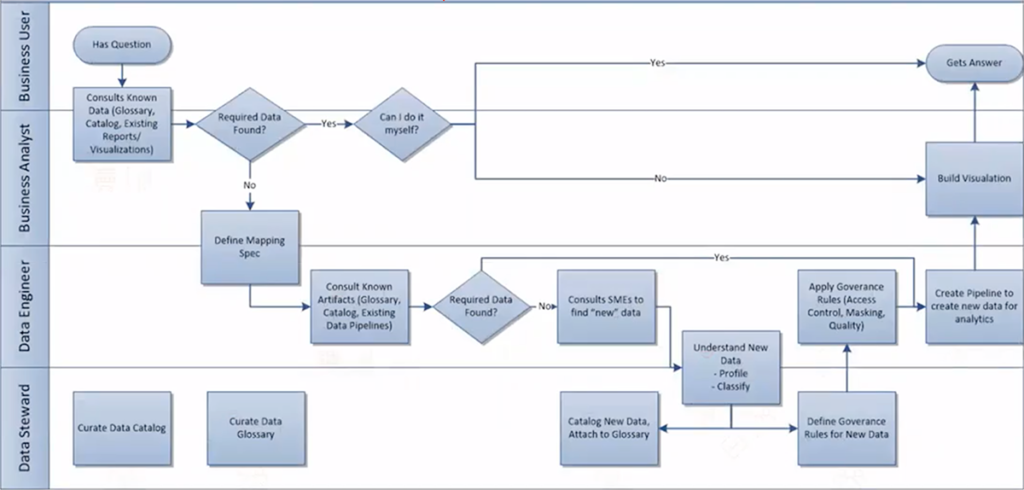Introduction:
In this data-driven world, businesses are struggling on a daily basis to store and access their amassing data and information. In a world where data is the lifeblood of business, seeking informed decisions based on stats is important. They need a well-defined approach and data architecture—blueprints for organizing, storing, and accessing this data in a structured form.
For this purpose, they require data management strategies that not only store their crucial data but also ensure its quality, security, and accessibility. For data architecture, businesses are implementing two prominent approaches: data fabric and data mesh.
In this article, we will open the debate regarding data fabric vs data mesh, explore their importance within the framework of organizational needs, highlight major differences, and assess their potential.
What is Data Fabric?
Imagine a business that has data flowing seamlessly across multiple systems, available and ready to analyze. That’s what data fabric is all about.
Data fabric is a contemporary approach to data architecture. It serves as a layer that brings together data from various sources, including databases, cloud storage, applications, etc. Data fabric leverages data virtualization to achieve this goal.
In simple terms, it creates a “virtual layer” of data that shields users from the complexities of the infrastructures they’re working with.
Data Fabric is All About Automation
Automation makes it easier to discover, move, and transform data. It also makes it faster and more reliable to deliver data, which is essential for data-driven decisions.
There are certain benefits of implementing a data fabric approach:
- Improved data quality
- Simplified data governance
- Reduced costs associated with siloed data
Importance of Data Fabric
Data fabric empowers organizations across industries. For example, in finance, data fabric consolidates customer and market data to provide comprehensive risk analysis. Similarly in healthcare, using this data fabric approach, you can easily create personalized treatment plans for patients by integrating data from multiple resources.
It doesn’t matter if you are looking to get detailed customer insights or want to optimize operations by analyzing structured data, this technique has got your back.
Let’s see what a data fabric workflow looks like:

Image Source: Informatica
What is Data Mesh
Unlike data fabric, which takes a monolithic view of data, data mesh takes a decentralized view. Data mesh views data as an end-product, owned and controlled by each business domain within the organization. Each business domain takes on the responsibility to build, transform, and deliver top-notch data products that meet their specific requirements. For example, imagine a team responsible for managing customer data. They would build and manage APIs and tools to access and analyze that data.
This self-service data infrastructure gives domain teams more control and flexibility. They can respond quickly to evolving data requirements without relying on siloed data governance structures. Data mesh also creates a data ownership culture where domain teams are responsible for the quality and integrity of their data products.
Key Consideration While Implementing Data Mesh
While decentralization can be beneficial, it necessitates a strong focus on collaboration and standardized data processes. Data mesh works best in organizations with defined business domains and ownership-driven cultures. It works best for large enterprises with heterogeneous data needs, like retail or media organizations where customer data is central to different departments.
Key Differences Between Data Mesh and Data Fabric
The difference between data mesh and data fabric is evident. Both frameworks are designed to meet the changing requirements of modern enterprises that manage large volumes of data. Data fabric is a framework that focuses on making data more accessible and useful. while Data mesh aims to improve the utilization of data. However, they differ significantly in their principles and implementation.
1- Architectural Philosophy
Data fabric uses a centralized control model, which provides a single layer of access and control throughout the organization. This centralization ensures consistent and efficient data management practices. On the other hand, data mesh uses a decentralized architecture, which emphasizes distributed ownership, where each business domain manages its data as separate products. This division enables each domain to adapt its data practices to particular needs and contexts, increasing agility and responsiveness.
2- Scalability and Flexibility
Data fabric’s scalability benefits organizations with consistent data requirements and environments that need a high degree of uniformity across the organization. Data mesh, on the other hand, provides unparalleled scalability by allowing domain-specific teams to adjust data solutions to diverse and changing needs.
Whether you’re working in a fast-paced market or adapting to emerging trends and technologies, flexibility and scalability is a key.
3- Data Governance
Data fabric streamlines compliance centralizes governance and data quality management throughout the enterprise. Because without any doubt data centralization plays a key role in regulated industries.
While data mesh on the other hand is based on a decentralized governance model. That allows domain teams to own their data, creating a sense of ownership and custom governance practices. This model requires a robust framework to ensure all domains adhere to common standards and best practices.
4- Complexity in Implementation
Talking about complexity, for many organizations, data fabric comes with a big upfront cost in terms of infrastructure. And it also requires a complete re-engineering of the data processes that are already in place.
Data mesh, on the other hand, allows for more gradual deployment. Organizations can add new domains to the data mesh as they are ready, reducing upfront costs and complexity.
5- Focus on Operations
Data mesh believes that data should be seen as a product, including lifecycle management and value-added to data consumers. The product-centric view of data aligns data initiatives with business outcomes.
On the other hand, Data fabric often uses automation and cutting-edge technologies such as knowledge graphs to link and manage data assets effectively. It focuses more on the technical side of data management than its business impact.
Ultimately, the choice between data fabric or data mesh depends on your organization’s requirements, governance approach, and strategic goals. Each has its own set of benefits and may be more appropriate for different organizational environments or data maturity milestones.
Selecting the Right Approach for Your Business: Data Fabric vs Data Mesh
If you are confused about which approach best suits your organization’s needs in the debate of data fabric vs data mesh, then consider the following factors before making any particular decision.
Organizational Readiness:
1- Data Maturity and Company Structure:
Data fabric can work well for organizations with a centralized data governance structure and well-established data management processes. On the other hand, data mesh may be better suited for larger data-centric businesses with defined business domains and ownership-oriented culture.
2- Infrastructure
Organizations with siloed, complex data architectures could benefit from the data fabric’s ability to bring them together. In contrast, data mesh can be built step-by-step, working in along with existing infrastructure.
Your organization’s long-term Strategic Goals
1- Data Governance
Data fabric makes data management easier and more consistent across the company. Data mesh needs more collaboration but can be useful for promoting data ownership across domains.
2- Data Analytics
One of Data Fabric’s key advantages is that it offers a unified view of data for analysis. Data mesh, on the other hand, prioritizes domain-specific data products, enabling teams to analyze data faster and more flexibly.
In-depth Research on Industry Expertise
Depending on your industry, you may need to consult experts or read case studies of successful data fabric or data mesh implementations. This can help you gain valuable insights into how similar organizations use these approaches.
Are you still thinking about which approach to choose? Make your decision based on the factors mentioned above, and most importantly, consider your organizational needs. Maybe your organization works best with a hybrid approach that incorporates elements of both data fabric and data mesh. Who knows?
Therefore, it’s important for you to consider every aspect or seek professional guidance before relying on a certain data architecture strategy for your business.
Conclusion
It’s your business, and you know best about your strategic needs. In order to select the ‘right’ approach for your amassed data management, you need to consider all factors. We’ve looked at the strengths and differences between data mesh and data fabric. Now it’s your call to decide which approach is right for you.
You don’t need to label the winner in the debate of data fabric vs data mesh. It really comes down to your organization’s structure, maturity of data, and strategic goals. It’s important to understand what your organization needs and capabilities are before deciding whether to go with a data fabric or a data mesh solution. Keep in mind that data management techniques change all the time. Be agile and stay on top of the latest developments.

